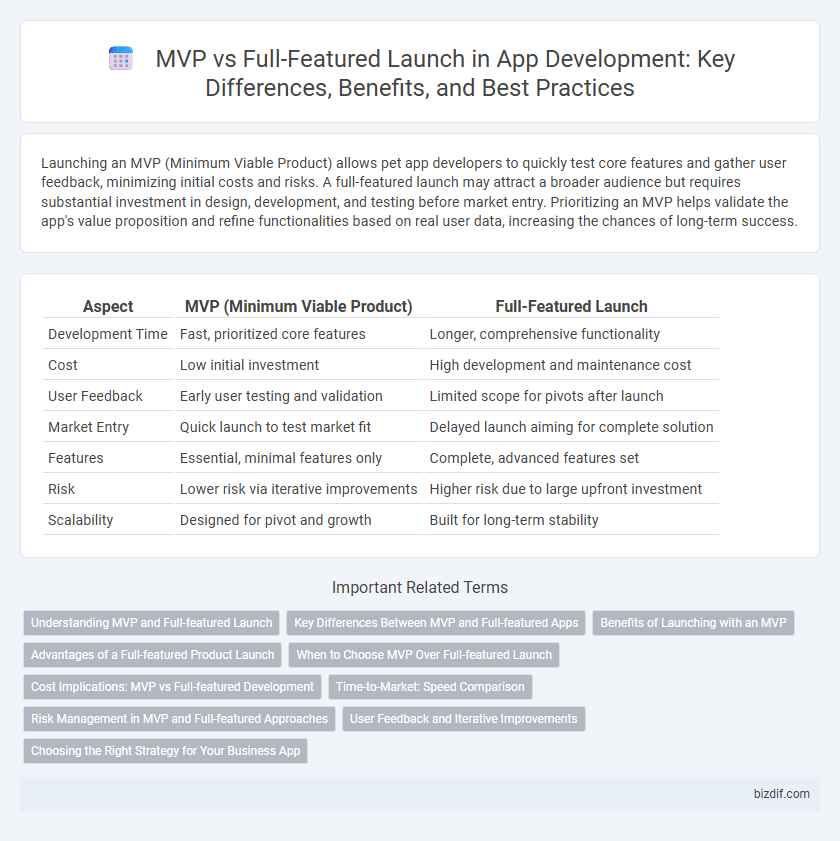Launching an MVP (Minimum Viable Product) allows pet app developers to quickly test core features and gather user feedback, minimizing initial costs and risks. A full-featured launch may attract a broader audience but requires substantial investment in design, development, and testing before market entry. Prioritizing an MVP helps validate the app's value proposition and refine functionalities based on real user data, increasing the chances of long-term success.
Table of Comparison
| Aspect | MVP (Minimum Viable Product) | Full-Featured Launch |
|---|---|---|
| Development Time | Fast, prioritized core features | Longer, comprehensive functionality |
| Cost | Low initial investment | High development and maintenance cost |
| User Feedback | Early user testing and validation | Limited scope for pivots after launch |
| Market Entry | Quick launch to test market fit | Delayed launch aiming for complete solution |
| Features | Essential, minimal features only | Complete, advanced features set |
| Risk | Lower risk via iterative improvements | Higher risk due to large upfront investment |
| Scalability | Designed for pivot and growth | Built for long-term stability |
Understanding MVP and Full-featured Launch
An MVP (Minimum Viable Product) is a basic version of an app with core features designed to test market demand and gather user feedback quickly. A full-featured launch includes a comprehensive set of functionalities aimed at providing a complete user experience and satisfying diverse customer needs. Understanding the trade-offs between MVP and full-featured launch helps optimize development time, budget, and product-market fit.
Key Differences Between MVP and Full-featured Apps
MVP (Minimum Viable Product) apps focus on delivering core functionalities to validate market demand quickly and cost-effectively, whereas full-featured apps offer comprehensive features aimed at maximizing user engagement and satisfaction. MVPs prioritize speed to market and user feedback for iterative improvements, while full-featured launches invest more time and resources upfront to provide a polished, scalable product. Key differences include development time, feature set complexity, and risk tolerance, with MVPs minimizing initial risk and full-featured apps targeting long-term market dominance.
Benefits of Launching with an MVP
Launching with a Minimum Viable Product (MVP) allows app developers to validate core functionalities and gather real user feedback early, reducing development costs and time-to-market. MVPs enable iterative improvements based on user behavior data, increasing the likelihood of product-market fit and minimizing the risk of extensive post-launch revisions. This approach focuses resources on essential features, ensuring efficient allocation and faster adaptation to changing market demands.
Advantages of a Full-featured Product Launch
A full-featured product launch offers a comprehensive user experience by integrating all planned functionalities, enhancing customer satisfaction and retention. It allows businesses to showcase the complete value proposition, positioning the app competitively in the market with robust features and seamless performance. Additionally, launching with a full-featured product minimizes frequent updates and patches, reducing long-term development costs and resource allocation.
When to Choose MVP Over Full-featured Launch
Choosing an MVP (Minimum Viable Product) over a full-featured launch is ideal when market validation and user feedback are critical for product success. MVP development prioritizes core functionalities to quickly test hypotheses and minimize time-to-market, reducing development costs and risks. This approach enables iterative improvements based on real user data before investing in extensive feature sets and scalability.
Cost Implications: MVP vs Full-featured Development
MVP development requires significantly lower upfront investment, enabling startups to validate core functionalities and market fit without extensive financial risk. Full-featured app launches demand higher costs due to comprehensive design, development, testing, and integration of advanced features, often extending timelines and budgets. Prioritizing MVP reduces initial expenditure and accelerates time-to-market, whereas full-featured launches necessitate substantial capital and resource allocation to deliver a complete user experience.
Time-to-Market: Speed Comparison
Launching a Minimum Viable Product (MVP) significantly reduces time-to-market compared to a full-featured app by focusing on core functionalities that address primary user needs. MVP development typically takes weeks to a few months, enabling rapid user feedback and iterative improvements, whereas full-featured apps require extensive development cycles of several months to over a year. Prioritizing speed in MVP launches helps startups quickly validate concepts and capture market opportunities before competitors with more complex solutions.
Risk Management in MVP and Full-featured Approaches
Launching an MVP (Minimum Viable Product) in app development mitigates risk by allowing early user feedback and iterative improvements, reducing costly errors before full-scale investment. In contrast, a full-featured launch involves higher initial development costs and greater market uncertainty, increasing the risk of product rejection or extensive post-launch fixes. Effective risk management prioritizes MVP strategies to validate core functionalities and market fit, minimizing financial exposure and optimizing resource allocation.
User Feedback and Iterative Improvements
Launching an MVP (Minimum Viable Product) prioritizes rapid user feedback to identify core needs and usability issues, enabling focused iterative improvements. Full-featured launches often delay this critical feedback loop, risking resource waste on underutilized or unwanted features. Continuous refinement based on real user data enhances product-market fit and drives sustainable growth in app development.
Choosing the Right Strategy for Your Business App
Selecting an MVP (Minimum Viable Product) approach enables faster market entry with core functionalities, facilitating user feedback and iterative improvements. A full-featured launch requires more development time and resources but can provide a comprehensive user experience and stronger initial brand impact. Evaluating factors like budget, target audience, competition, and time-to-market goals is crucial to choosing the ideal strategy for your business app.
MVP vs Full-featured launch Infographic

 bizdif.com
bizdif.com